Students can Download Tamil Nadu 11th Economics Model Question Paper 2 English Medium Pdf, Tamil Nadu 11th Economics Model Question Papers helps you to revise the complete Tamilnadu State Board New Syllabus, helps students complete homework assignments and to score high marks in board exams.
TN State Board 11th Economics Model Question Paper 2 English Medium
General Instructions:
- The question paper comprises of four parts.
- You are to attempt all the parts. An internal choice of questions is provided wherever applicable.
- All questions of Part I, II, III and IV are to be attempted separately.
- Question numbers 1 to 20 in Part I are Multiple Choice Questions of one mark each.
These are to be answered by choosing the most suitable answer from the given four alternatives and writing the option code and the corresponding answer - Question numbers 21 to 30 in Part II are two-mark questions. These are to be answered in about one or two sentences.
- Question numbers 31 to 40 in Part III are three-mark questions. These are to be answered in above three to five short sentences.
- Question numbers 41 to 47 in Part IV are five-mark questions. These are to be answered in detail Draw diagrams wherever necessary.
Time: 3:00 Hours
Maximum Marks: 90
PART – I
Choose the correct answer. Answer all the questions: [20 × 1 = 20]
Question 1.
In the first five year plan, the top priority was given to ………………. sector?
(a) Service
(b) Industrial
(c) Agriculture
(d) Bank
Answer:
(b) Industrial
![]()
Question 2.
Which union Territory has the highest sex ratio?
(a) Chandigarh
(b) Pondicherry
(c) Lakshadweep
(d) Andaman & Nicobar
Answer:
(b) Pondicherry
Question 3.
Data processing is done by ………………..
(a) PC alone
(b) Calculator alone
(c) Both PC and Calculator
(d) Pen drive
Answer:
(c) Both PC and Calculator
![]()
Question 4.
In India’s total cement production, Tamil Nadu ranks …………………
(a) Third
(b) Fourth
(c) First
(d) Second
Answer:
(a) Third
Question 5.
Wage is an example for …………. cost of the production.
(a) Fixed
(b) Variable
(c) Marginal
(d) Opportunity
Answer:
(b) Variable
Question 6.
Innovation Theory of profit was given by ………………
(a) Hawley
(b) Schumpeter
(c) Keynes
(d) Knight
Answer:
(b) Schumpeter
![]()
Question 7.
Which of the following is wrongly matched?
(a) Gateway of Tamil Nadu – Thoothukudi
(b) Home textile city – Erode
(c) Steel city – Salem
(d) Pump city – Coimbatore
Answer:
(b) Home textile city – Erode
Question 8.
VKRV Rao was a student of ……………
(a) JM Keynes
(b) Colin Clark
(c) Adam Smith
(d) Alfred Marshal
Answer:
(a) JM Keynes
Question 9.
Group equilibrium is analysed in ………………….
(a) Monopolistic competition
(b) Monopoly
(c) Duopoly
(d) Pure competition
Answer:
(a) Monopolistic competition
![]()
Question 10.
………………… have exchange value and their ownership rights can be established and exchanged.
(a) Goods
(b) Services
(c) Markets
(d) Revenue
Answer:
(a) Goods
Question 11.
Which feature is identified with mral areas?
(a) Low population density
(b) High population density
(c) Low natural resources
(d) Low human resources
Answer:
(a) Low population density
Question 12.
The number of births per thousand population is called as ………….
(a) Crude death rate
(b) Mortality rate
(c) Morbidity rate
(d) Crude Birth Rate
Answer:
(d) Crude Birth Rate
![]()
Question 13.
“Wages as a sum of money are paid under contract by an employer to a worker for services rendered.” Who said this?
(a) Benham
(b) Marshall
(c) Walker
(d) J. S. Mill
Answer:
(a) Benham
Question 14.
Identify the formula of estimating average variable cost ……………
(a) TC/Q
(b) TVC/Q
(c) TFC/Q
(d) TAC/Q
Answer:
(b) TVC/Q
![]()
Question 15.
Data processing is done by …………..
(a) Pc alone
(b) Calculator alone
(c) Both pc and calculator
(d) Penen drive
Answer:
(c) Both pc and calculator
Question 16.
HDI was constructed based on …………..
(a) Life expectancy index
(b) Education index
(c) GDP per capita
(d) All the above
Answer:
(d) All the above
Question 17.
The command Ctrl + M is applied for ……………….
(a) Saving
(b) Copying
(c) Getting new slide
(d) Deleting a slide
Answer:
(c) Getting new slide
![]()
Question 18.
Ryotwari System was initially introduced in ……………….
(a) Kerala
(b) Bengal
(c) Tamil Nadu
(d) Maharashtra
Answer:
(c) Tamil Nadu
Question 19.
Loanable funds theory of interest is called ………….
(a) Classical theory
(b) Modern theory
(c) Traditional theory
(d) Neo – classical theory
Answer:
(d) Neo – classical theory
![]()
Question 20.
The main theme of the Twelth Five year plan ………………..
(a) Faster and more inclusive, growth
(b) Growth with social justice
(c) Socialistic pattern of society
(d) Faster, more inclusive and sustainable growth
Answer:
(d) Faster, more inclusive and sustainable growth
PART – II
Answer any seven question in which Question No. 30 is compulsory. [7 × 2 = 14]
Question 21.
Define disinvestment?
Answer:
Disinvestment means selling of government securities of Public Sector Undertakings [PSUs] to other PSUs or Private Sectors or banks. This process has not been fully implemented.
![]()
Question 22.
Give the definition for “Real cost”?
Answer:
Real Cost refers to the payment made to compensate the efforts and sacrifices of all factor owners for their services in production. Real Cost includes the efforts and sacrifices of landlords in the use of land, capitalists to save and invest, and workers in foregoing leisure. Real cost are considered pains and sacrifices of labour as real cost of production.
![]()
Question 23.
Define Labour?
Answer:
- Labour is the active factor of production.
- In common parlance, labour means manual labour or unskilled work. But in Economics the term ‘labour’ has a wider meaning.
- It refers to any work undertaken for securing an income or reward. Such work may be manual or intellectual. For example, the work done by an agricultural worker or a cook dr rickshaw puller or a mason is manual.
- The work of a doctor or teacher or an engineer is intellectual.
- In short, labour in economics refers to any type of work performed by a labourer for earning an income.
![]()
Question 24.
What is the difference between HDI and PQLI?
Answer:
|
HDI |
PQLI |
| 1. The Inclusion of Income. | 1. The exclusion of Income. |
| 2. Both Physical and financial attributes of development | 2. Only the physical aspects of life. |
Question 25.
Classify the factors of production?
Answer:
- Land
- Labour
- Capital and
- Organisation
1. Land:
In Economics, land means all gifts of Nature owned and controlled by human beings which yield an income.
2. Labour:
Labour means manual labour or unskilled work.
3. Capital:
“Capital consists of all kinds of wealth other than free gifts of nature, which yield income”. Bohm – Bawerk defines it as ‘a produced means of production’.
4. Organisation:
The man behind organizing the business is called as ‘Organizer’ or ‘Entrepreneur’.
![]()
Question 26.
State the meaning of Indifference curves?
Answer:
- The Consumer is rational and his aim is to derive maximum satisfaction.
- Utility cannot be cardinally measured, but can be ranked or compared or ordered by ordinal number. Such as I, II, III and so on.
- Indifference curve approach is based on the concept “Diminishing Marginal Rate of Substitution”.
- The consumer is consistent this assumption is called as the assumption of transitivity.
Question 27.
Define micro economics?
Answer:
- Micro economics is the study of the economic actions of individual units say households, firms or industries.
- It studies how business firms operate under different market conditions.
- The combined actions of buyers and sellers determine prices.
- Micro economics covers:
- Value theory [product pricing and factor pricing]
- Theory of economic welfare.
![]()
Question 28.
Define Rent?
Answer:
Rent is the price or reward given for the use of land or house or a machine to the owner. But, in Economics, “Rent” or “Economic Rent” refers to that part of payment made by a tenant to his land lords for the use of land only.
Question 29.
What are the characteristics of land?
Answer:
- Land is a primary factor of production
- Land is a passive factor of production
- Land is the free gift of nature
- Land has no cost of production
- Land is fixed in supply. It is inelastic in supply
- Land is permanent
- Land is immovable
- Land is heterogeneous as it differs in fertility
- Land has alternative uses
- Land is subject to Law of Diminishing Returns.
![]()
Question 30.
Give the meaning of deductive method?
Answer:
- Deductive method is also named as analytical or abstract method.
- It consists in deriving conclusions from general truths.
- It takes few general principles and applies them to draw conclusions.
- The classical and neo – classical school of economists notably, Ricardo, JS Mill, Malthus Marshall, Pigou applied the deductive method in their economic investigations
PART – III
Answer any seven question in which Question No. 40 is compulsory. [7 × 3 = 21]
Question 31.
What are the features of a market?
Answer:
A market has the following characteristic features:
- Buyers and sellers of a commodity or a service.
- A commodity to be bought and sold.
- Price agreeable to buyer and seller.
- Direct or indirect exchange.
![]()
Question 32.
Write a note on Mineral resources in Tamil Nadu?
Answer:
Mineral Resources in Tamil Nadu:
- Tamil Nadu has a few mining projects based on Titanium, Lignite, Magnesite, Graphite, Limestone, Granite and Bauxite.
- The first one is the Neyveli Lignite Corporation that has led development of large industrial complex around Neyveli in Cuddalore district with Thermal Power Plants, Fertilizer and Carbonisation plants.
- Magnesite mining is at Salem from which mining of Bauxite ores are carried out at Yercaud, and this region is also rich in iron ore at Kanjamalai.
- Molybdenum is found in Dharmapuri, and is the only source in the country.
![]()
Question 33.
State the features of duopoly?
Answer:
- Each seller is fully aware of his rival’s motive and actions.
- Both sellers may collude, (they agree on all matters regarding the sale of the commodity).
- They may enter into cut – throat competition.
- There is no perfect differentiation.
- They fix the price for their product with a view to maximising their profit.
Question 34.
Mention the relationship between marginal utility and total utility?
Answer:
|
Marginal utility |
Total utility |
| 1. Marginal utility goes on diminishing. | 1. Total utility goes on Increasing. |
| 2. Marginal utility becomes zero’ | 2. Total utility maximum. |
| 3. Marginal utility becomes negative. | 3. Total utility diminishes. |
![]()
Question 35.
Explain different types of economic activities?
Answer:
The seven types of economic activities are:
1. Micro Economics:
Micro Economics is the study of the economic actions of individuals . say households, firms or industries.
Micro economics covers:
- Value theory [product pricing and factor pricing]
- Theory of economic welfare.
2. Macro – Economics:
- Macro economics is the obverse of micro economics.
- The general theory of employment, Interest and money published by Keynes is the basis of modem macro economics.
3. International Economics:
- In the modem world, no country can grow in isolation.
- Every country is having links with the other countries through foreign capital, investment [foreign direct investment] and international trade.
4. Public Economics:
- Public finance is concerned with the income or revenue raising and expenditure incurring activities.
- The scope of public finance covers public expenditure, public revenue, public debt and financial administration.
5. Developmental Economics:
The development economics deals with features of developed nations, obstacles for development, economic and non- economic factors influencing development, various growth models and strategies.
6. Health Economics:
- Health economics is an area of applied economics.
- It covers health indicators , preventive and curative measures, medical research and education, rural health mission, drug price control, neo -natal care, maternity and child health, budgetary allocation for health.
7. Environmental Economics:
- Depletion of natural resources stock and pollution result from rapid economic development.
- Environmental economics is a study of inter disciplinary tools for the problems of ecology, economy and environment.
![]()
Question 36.
Discuss the long run cost curves with suitable diagram?
Answer:
1. In the long run all factors of production become variable. The existing size of the firm can be increased in the case of long run. There are neither fixed inputs nor fixed costs in the long run.
2. LAC is given in diagram.
3. Long run average cost (LAC) is equal to long run total costs divided by the level of output.
LAC = LTC/Q
4. where, LAC denotes Long – Run Average Cost, LTC denotes Long – run Total Cost and Q denotes the quantity of output. The LAC curve is derived from short – run average cost curves. It is the locus of points denoting the least cost curve of producing the corresponding output. The LAC curve is called as ‘Plant Curve’ or ‘Boat shape Curve’ or ‘Planning Curve’ or ‘Envelop Curve’.
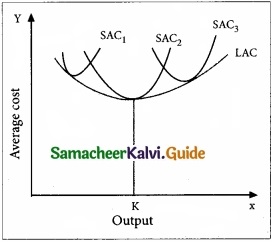
![]()
Question 37.
Elucidate different features of services?
Answer:
Along with goods, services, are produced and consumed. They are generally, possess the following:
(I) Intangible:
- Intangible things are not physical obj ects but exist in connection to other things for example, brand image, good will etc.
- The intangible things are converted and stored into tangible items such as recording a music piece into a pen – drive.
(II) Heterogeneous:
- Services vary across regions or cultural backgrounds.
- A single type service yields multiple experiences, e.g., music, consulting physicians etc.
(III) Inseparable from their makers:
Services are inextricably connected to their makes. For example, labour and labourers are inseparable.
(IV) Perishable:
- Services cannot be stored as inventories like assets.
- For example it is useless to possess a ticket for a cricket match once the match is over.
- It cannot be stored and it has no value in exchange.
![]()
Question 38.
State the Dynamic Theory of Profit?
Answer:
Dynamic Theory of Profit:
- This theory was propounded by the American economist J.B.Clark in 1900.
- Profit is the reward for dynamic changes in society.
- Static society is one where everything is stationary or stagnant and there is no change at all.
- There is no role for an entrepreneur in a static society.
- According to Clark, the following five main changes are taking place in a dynamic society.
- Population is increasing
- Volume of Capital is increasing
- Methods of production are improving
- Forms of industrial organization are changing
- The wants of consumer are multiplying
Question 39.
State the reasons for nationalization of commercial banks?
Answer:
- After Independence, the Government of India adopted planned economic development.
- Five year plans came into existence since 1951.
- The main objective of the economic planning aimed at social welfare.
- Before Independence commercial banks were in the private sector.
- These commercial banks failed in helping the Government to achieve social objectives of planning.
- Therefore, the government decided to nationalize 14 major commercial banks on 19 July 1969.
- In 1980, again the government took over another 6 commercial banks.
![]()
Question 40.
Write a short note on Welfare Economics given by Amartya Sen?
Answer:
- Amartya Kumar Sen. has included the concept of entitlement items like nutrition, food, medical and health care, employment, security of food supply in times of famine etc.
- He considered famine as arising out of the failure of establishing a system of entitlements.
PART – IV
Answer all the questions. [7 × 5 = 35]
Question 41 (a).
Briefly explain the subsistence theory of wages?
Answer:
The subsistence theory of wages:
- Subsistence theory of wages is one of the oldest theories of wages.
- According to this theory, wage must be equal to the subsistence level of the labourer and his family.
- Subsistence means the minimum amount of food, clothing and shelter which workers and their family require for existence.
- If workers are paid higher wages than the subsistence level, the workers would be better off and they will have large families.
- Hence, the population would increase.
- When the population increases, the supply of labourer would increase and therefore, wages will come down.
- If wages are lower than the subsistence level, there would be a reduction in population and thereby the supply of labour falls and wages increase to the subsistence level.
[OR]
(b) Elucidate the loanable funds theory of Interest?
Answer:
- The Loanable Funds Theory, also known as the “Neo – Classical Theory,” was developed by Swedish economists like Wicksell, Bertil, Ohlin,.Viner, Gunnar Myrdal and others.
- According to this theory, interest is the price paid for the use of loanable funds.
- The rate of interest is determined by the equilibrium between demand for and supply of loanable funds in the credit market.
Demand for loanable funds:
The demand for loanable funds depends upon the following:
(I) Demand for Investment [I]
- The most important factor responsible for the loanable funds is the demand for investment.
- Bulk of the demand for loanable funds comes from business firms which borrow money for purchasing capital goods.
(II) Demand for consumption [C]
The demand for loanable funds comes from individuals who borrow money for consumption purposes also.
(III) Demand for Hoarding [H]
- The next demand for loanable funds comes from hoarders. Demand for hoarding money arises because of people’s preference for liquidity, idle cash balances and so on.
- The demand for C, I and H varies inversely with interest rate.
Supply of Loanable funds:
The supply of loanable funds depends upon the following four sources:
1. Savings [S]:
Loanable funds comes from savings. According to this theory, savings may be of two types, namely,
- Savings planned by individuals are called “ex – ante – savings
- The unplanned savings are called ‘ex-post savings”.
2. Bank Credit [BC]:
The bank credit is another source of loanable funds. Commercial banks create credit and supply loanable funds to the investors.
3. Dishoarding [DH]:
Dishoarding means bringing out the hoarded money into use and thus it constitutes a source of supply of loanable funds.
4. Disinvestment [DI]:
Disinvestment is the opposite of investment. Disinvestment means not providing sufficient funds for depreciation of equipment.
It gives rise to the supply of loanable funds. All the four sources of supply of loanable funds vary directly with the interest rate.
![]()
Question 42 (a).
Illustrate the uncertainty Bearing Theory of profit?
Answer:
Uncertainty theory was propounded by the American economist Frank H.Knight. Profit is the reward for “ uncertainty bearing”. He distinguishes between “ Insurable” and “non – insurable” risks.
Insurable Risks:
- Certain risks are measurable or calculable.
- Some of the examples of these risks are the risk of fire, theft and natural disasters.
- Such risks are compensated by the Insurance companies.
Non – Insurable Risks:
- There are some risks which are immeasurable or incalculable.
- The examples of these risks are competition, market condition, technology change and public policy.
- No Insurance Company can undertake these risks.
- The term “risks” covers the first type of events (measurable – insurable)
- The term “uncertainty” covers the second type of events (unforeseeable or incalculable or not measurable or non-insurable).
- According to Knight, profit does not arise.
- On account of risk-taking, because the entrepreneur can guard himself against a risk by taking a suitable insurance policy.
- Uncertain events cannot be guarded against in that way.
- An entrepreneur takes himself the burden of facing an uncertain event, he secures remuneration.
- That remuneration is “profit”.
[OR]
(b) Write a brief note on the Gandhian economic ideas?
Answer:
Gandhian Economics is based on ethical foundations. Gandhi wrote “ Economics that hurts the moral well-being of an individual or a nation is immoral, and therefore , Sinful”. Gandhi repeated the same belief “ that economy is untrue which ignores or disregards moral values”.
Salient features of Gandhian Economic Thought:
(I) Village Republics:
- India lives in villages.
- He was interested in developing the villages as self – sufficient units.
- He opposed extensive use of machinery, urbanization and industrialization.
(II) On Machinery:
- Gandhi described machinery as ‘Great sin’. He said that “Books could be written to demonstrate its evils”.
- It is necessary to realize that machinery is bad.
- Instead of welcoming machinery as a boon, we should look upon it as an evil.
- It would ultimately cease.
(III) Industrialism:
- Gandhi considered industrialism as a curse on mankind.
- He thought industrialism depended entirely on a country’s capacity to exploit.
(IV) Decentralization:
Gandhi advocated a decentralized economy i.e., production at a large number of places on a small scale or production in the people’s homes.
(V) Village Sarvodaya:
- According to Gandhi, “Real India was to be found in villages and not in towns or cities”.
- He suggested, self – dependent villages.
(VI) Bread Labour:
- Gandhi realized the dignity of human labour.
- He believed that God created man to eat his bread by the sweat of his brow.
- Bread labour or body labour was the expression that Gandhi used to mean manual labour.
(VII) The Doctrine of Trusteeship:
Trusteeship provides a means of transforming the present capitalist order of society into an egalitarian one.
(VIII) On the Food Problem:
- Gandhi was against any sort of food controls.
- Once India was begging for food grain, but now India tops the world with very large production of food grains, fruits, vegetables, milk, egg, meat etc.
(IX) On Population:
- Gandhi opposed the method of population control through contraceptives.
- He was, however, in favour of birth control through Brahmacharya or self – control.
- He considered self – control as a sovereign remedy to the problem of over population,
(X) On Prohibition:
- Gandhi regarded the use of liquor as a disease rather than a vice.
- He felt that it was better for India to be poor than to have thousands of drunkards.
- Many states depend on revenue from liquor sales.
![]()
Question 43 (a).
Explain the various sources of energy in Tamil Nadu?
Answer:
Tamil Nadu tops in power generation among the Southern States as seen in the table.
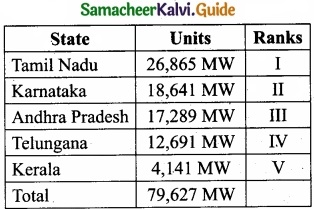
Tamil Nadu 26,865 MW in 1st Rank in the energy level. Tamil Nadu is in the forefront of all other Indian States in installed capacity. Muppandal wind farm is a renewable energy source, supplying the villagers with electricity for work.
Wind farms were built in Nagercoil and Tuticorin apart from already existing ones around Coimbatore, Pollachi, Dharapuram and Udumalaipettai. These areas generate about half of India’s 2,000 megawatts of wind energy or two percent of the total power output of India.
Nuclear Energy:
The Kalpakkam Nuclear Power Plant and the Koodankulam Nuclear Power Plant are the major nuclear energy plants for the energy grid.
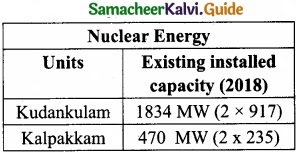
Thermal power:
- In Tamil Nadu the share of thermal power in total energy sources is very high and the thermal power plants are at Athippattu (North Chennai) Ennore, Mettur, Neyveli and Thoothukudi.
- The generation of power under various sources is given below.
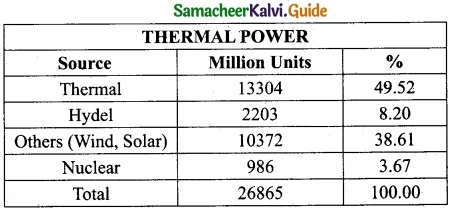
Hydel Energy:
- There are about 20 hydro – electric units in Tamil Nadu.
- The prominent units are Hundah, Mettur, Periyar, Maravakaiidy, Parson Valley etc.
Solar Energy:
- Tamil Nadu tops in solar power generation in India as’seen in following table
- Southern Tamil Nadu is considered as one of the most suitable regions in the country for developing solar power projects.
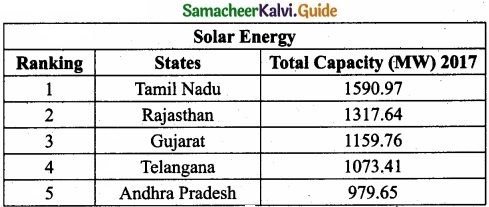
Wind Energy:
- Tamil Nadu has the highest installed wind energy capacity in India.
- The State has very high quality of offshore wind energy potential off the Tirunelveli coast and southern Thoothukudi and Rameswaram coast.
[OR]
(b) A firm has the revenue function. R = 600 q – 0.03 q2 and the cost function is C = 150 q + 60,000, where q is the number of units produced, find AR, AC, MR and MC?
Answer:
(I) Average Revenue = \(\frac{R}{q}\)
\(\frac { 600q-0.03{ q }^{ 2 } }{ q } \) = \(\frac{600q}{q}\) – \(\frac { 0.03{ q }^{ 2 } }{ q } \)
AR = 600 – 0.03q
(II) Average cost = \(\frac{C}{q}\)
= \(\frac{150q+60000}{q}\)
= \(\frac{150q}{q}\) + \(\frac{60000}{q}\)
AC = 150 + \(\frac{60000}{q}\)
(III) Marginal Revenue = \(\frac{dR}{dq}\)
R = 600q – 0.03q2
\(\frac{dR}{dq}\) = 600 – (0.03)(2q)
MR = 600 – 0.06q
(IV) Marginal Cost = \(\frac{dC}{dq}\)
C = 150q + 60000
MC = 150
![]()
Question 44 (a).
Explain the causes for Rural Backwardness?
Answer:
- The evils of brain – drain and rural – urban migration can be reduced if rural areas are developed.
- In order to better utilise the unused and under – utilised resources there is a need to develop the rural economy.
- Rural Development should minimise the gap between rural and. urban areas in terms of the provision of infrastructural facilities. It was called as PURA by former President Abdul Kalam.
- In order to improve the nation’s status in the global arena in terms of the economic indicators like,
- Human Development Index [HDI]
- Woman Empowerment Index [WEI]
- Gender Disparity Index [GDI]
- Physical Quality of Life Index [PQLI] and
- Gross National Happiness Index [GNHI] should be given due attention.
[OR]
(b) The features of Rural Economy are peculiar. Argue?
Answer:
Features of Rural Economy:
(I) Village is an Institution:
The village is a Primary Institution and it satisfies almost all the needs of the rural community. The rural people have a feeling of belongingness and a sense of unity towards each other.
(II) Dependence on Agriculture:
The rural economy depends much on nature and agricultural activities. Agriculture and allied activities are the main occupation in rural areas.
(III) Life of Rural people:
Lifestyles in villages are very simple. Public services like education, housing, health and sanitation, transport and communication, banking, roads and markets are limited and unavailable. The standards of living of majority of rural people are poor and pitiable. In terms of methods of production, social organization and political mobilization, rural sector is extremely backward and weak.
(IV) Population Density:
Population density, measured by number of persons living per sq.km is very low and houses are scattered in the entire villages.
(V) Employment:
There exists unemployment, seasonal unemployment and under employment in rural areas.
(VI) Poverty:
Poverty is a condition where the basic needs of the people like food, clothing and shelter are not being met.
(VII) Indebtedness:
People in rural areas are highly indebted owing to poverty and underemployment, lack of farm and non – farm employment opportunities, low wage employment, seasonality in production, poor marketing network etc.
(VIII) Rural Income:
The Income of the rural people is constrained as the rural economy is not sufficiently vibrant to provide them.
(IX) Dependency:
Rural households are largely dependent on social grants and remittances from family members working in urban areas and cities.
(X) Dualism:
Dualism means the co – existence of two extremely different features like developed and under developed. These characteristics are very common in rural areas.
(XI) Inequality:
The distributions of income, wealth and assets are highly skewed among rural people. Land, livestock and other assets are owned by a few people.
(XII) Migration:
Rural people are forced to migrate from villages to urban areas in order to seek gainful employment for their livelihood.
![]()
Question 45 (a).
Compare productivity of any two food crops between Tamil Nadu and India?
Answer:
Productivity position of Tamil Nadu and India
- The Government of Tamil Nadu lays emphasis on agricultural production and productivity.
- Tamil Nadu tops in productivity, in food crops as well as non-food crops among the states in India.
Productivity position of Tamil Nadu in India
- Tamil Nadu ranks first in maize, cumbu, groundnut, oil seeds and cotton.
- Tamil Nadu ranks second in rice and coconut.
- Tamil Nadu ranks third in sugarcane, sunflower and Jowar.
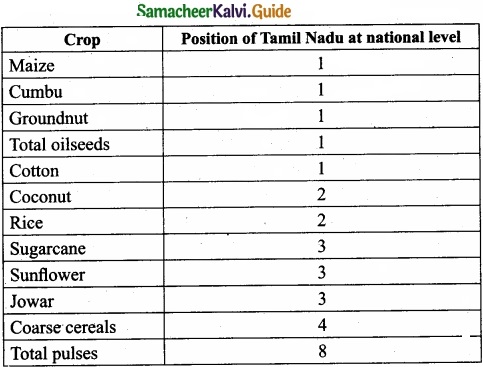
[OR]
(b) Describe the “MSMES”?
Answer:
- The Micro, Small and Medium Enterprises are defined under the MSMED Act 2006.
- The enterprises are classified as Manufacturing and Service enterprises based on the investment in plant and machinery and equipment (excluding land and building).
- Tamil Nadu accounts of 15.07% Micro, Small and Medium Enterprises (MSMEs) in the country (the highest among all States) with 6.89 lakhs registered MSMEs.
- Producing over 8000 varieties of product for a total investment of more than ₹32,008 crore.
- MSMEs produce a wide variety of products in almost all sectors.
- The prominent among them are the engineering, electrical, chemicals, plastics, steel paper, matches, textiles, hosiery and garments sector.
- Around 15.61 lakh entrepreneurs have registered, providing employment opportunities to about 99.7 lakhs persons with total investment of Rs. 1,68,331 crore.
![]()
Question 46 (a).
Write a short note on Marginal Revenue?
Answer:
- Marginal Revenue [MR] is the addition to the total revenue by the sale of an additional unit of a commodity.
- MR can be found out by dividing change in total revenue by the change in quantity sold out.
- MR = ∆TR/AQ where MR denotes Marginal Revenue, ∆TR denotes change in Total Revenue and ∆Q denotes change in total quantity.
- The other method of estimating MR is:
MR = TRn – TRn – 1 (or) TRn+1 – TRn
Where, MR denotes Marginal Revenue,
TR denotes total revenue of nth item,
TRn-1 denotes Total Revenue of n – 1th item and
TRn+1 denotes Total Revenue of n + 1th item.
If TR = PQ , MR = dTR/dQ = P, which is equal to AR.
[OR]
(b) Describe the degrees of price discrimination?
Answer:
Degrees of Price Discrimination:
Price discrimination has become widespread in almost all monopoly markets. According to A.C.Pigou, there are three degrees of price discrimination.
(I) First degree price discrimination:
A monopolist charges the maximum price that a buyer is willing to pay. This is called as perfect price discrimination. This price wipes out the entire consumer’s surplus. This is maximum exploitation of consumers. Joan Robinson named it as “Perfect Discriminating Monopoly”.
(II) Second degree price discrimination:
Under this degree, buyers are charged prices in such a way that a part of their consumer’s surplus is taken away by the sellers. This is called as imperfect price discrimination. Joan Robinson named it as “Imperfect Discriminating Monopoly”.
Under this degree, buyers are divided into different groups and a different price is charged for each group. For example, in cinema theatres, prices are charged for same film show from viewers of different classes. In a theatre the difference between the first row of first class and the last row in the second class is smaller as compared to the differences in charges..
(III) Third degree price discrimination:
The monopolist splits the entire market into a few sub – market and charges different price in each sub – market. The groups are divided on the basis of age, sex and location. For example, railways charge lower fares from senior citizens. Students get discounts in museums, and exhibitions.
![]()
Question 47 (a).
Elaborate the nature and scope of Economics?
Answer:
Economics nature:
- The nature of a subject refers to its contents and how and why they find a place in the subject.
- This nature is understood by studying the various definitions given by the notable economists.
- The existence of multiplicity of the definitions makes some scholars comment that a search for a clear definition of economics is an exercise in futility.
- “Political economy is said to have strangled itself with definitions.”
- Their presence makes studying a subject interesting, exciting, enjoyable or worthwhile.
- In fact their presence in a social science subject is a clear sign of the growth of the science.
- It indicates that there exists freedom for people associated with such as science to formulate fresh definitions.
Scope of economics:
- The scope of the subject of economics refers to on the subject matter of economics.
- It throws light on whether it is an art or science and if science, whether it is a positive science or a normative science.
Economics subject matter:
- Economics focuses on the behaviour and interactions among economic agents, individuals and group belonging to an economic system.
- Economics studies the ways in which people use the available resources to satisfy their multiplicity of wants.
- The activities of rational or normal human beings are the subject-matter of economics.
[OR]
(b) Explain the Internal and external economics of scale?
Answer:
Internal Economics of Scale:
- Internal Economies of scale refers to the advantages enjoyed by the production unit which causes a reduction in the cost of production of the commodity.
- For example, a firm enjoying the advantage of an application of most modem machinery, generation of internal capital, an improvement in managerial skill etc. are sure to reduce the cost of production. They are of various types:
(a) Technical Economies:
- When the size of the firm is large, large amount of capital can be used.
- There is a possibility to introduce up – to – date technologies this improves productivity of the firm.
- Research and development strategies can be applied easily.
(b) Financial Economies:
Big firms can float shares in the market for capital expansion, while small firms cannot easily float shares in the market.
(c) Managerial Economies:
Large scale production facilitates specialization and delegation.
(d) Labour Economies:
- Large scale production implies greater and minute division of labour.
- This leads to specialization which enhances the quality.
- This increases the productivity of the firm.
(e) Marketing Economies:
- In the context of large scale production, the producers can both buy raw-materials in bulk at cheaper cost and can take the products to distant markets.
- They enjoy a huge bargaining power.
(f) Economies of survival:
- Product diversification is possible when there is large scale production.
- This reduces the risk in production.
- Even if the market for one product collapses, market for other commodities offsets it.
External Economies of Scale:
- External Economies of Scale refer to changes in any factor outside the firm causing an improvement in the production process.
- This can take place in the case of industry also.
- These are the advantages enjoyed by all the firms in industry due to the structural growth.
- Important external economies of scale are listed below :
- Increased transport facilities
- Banking facilities
- Development of townships
- Development of information and communication.